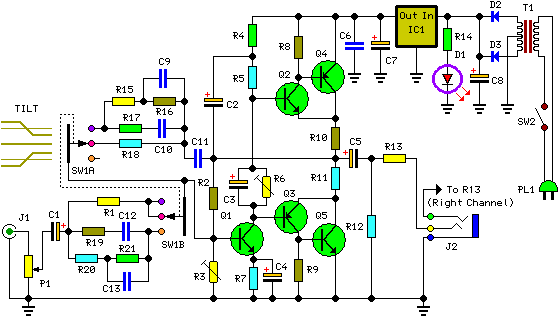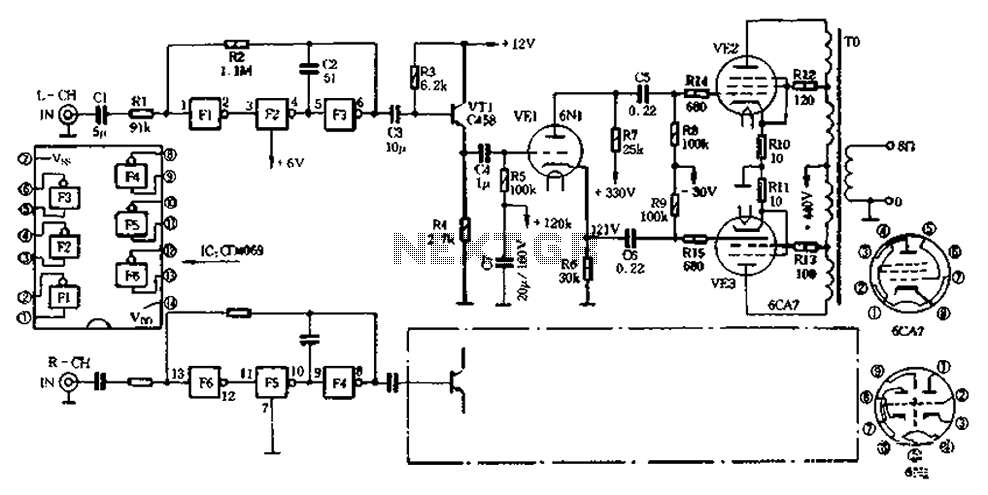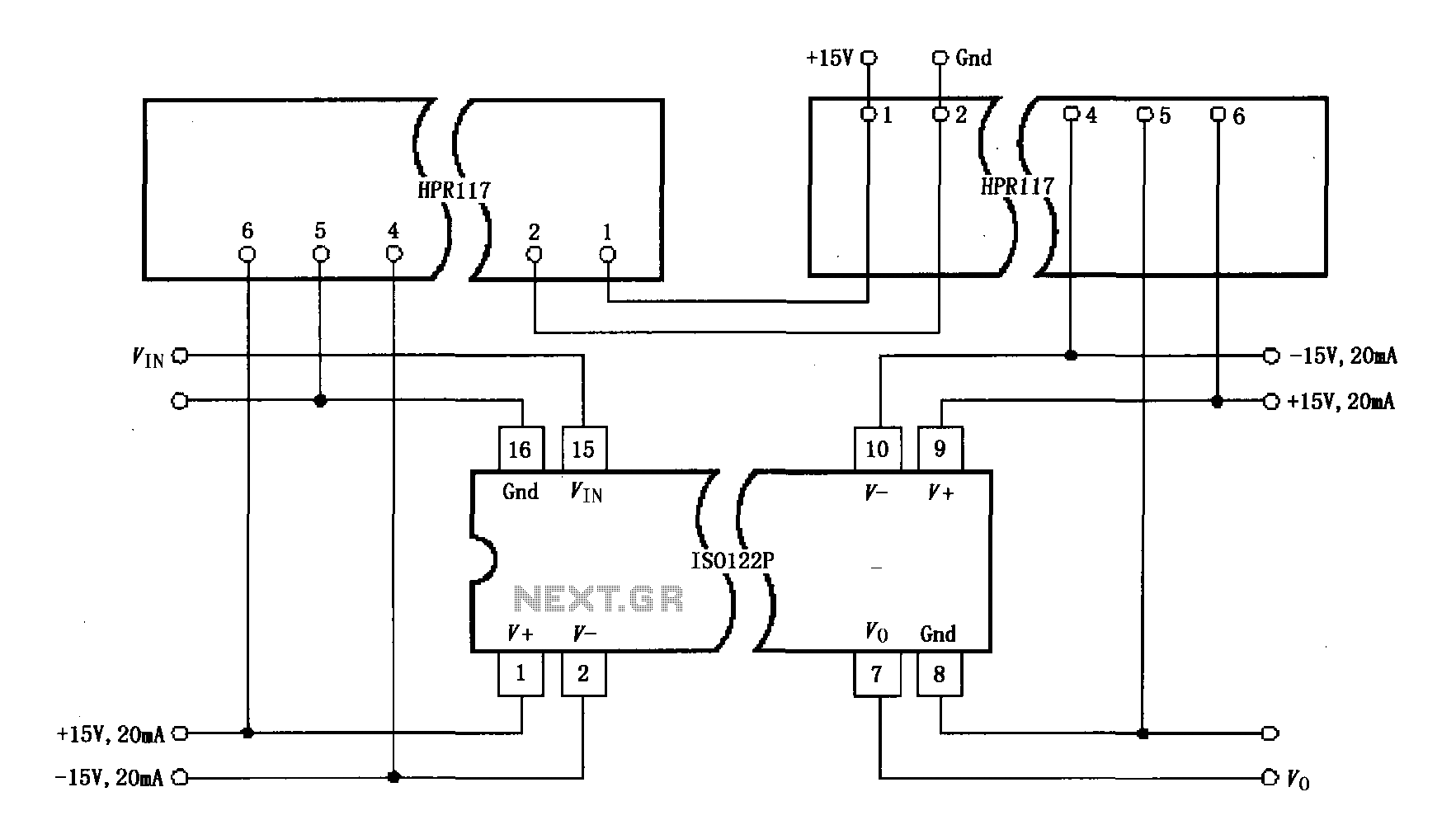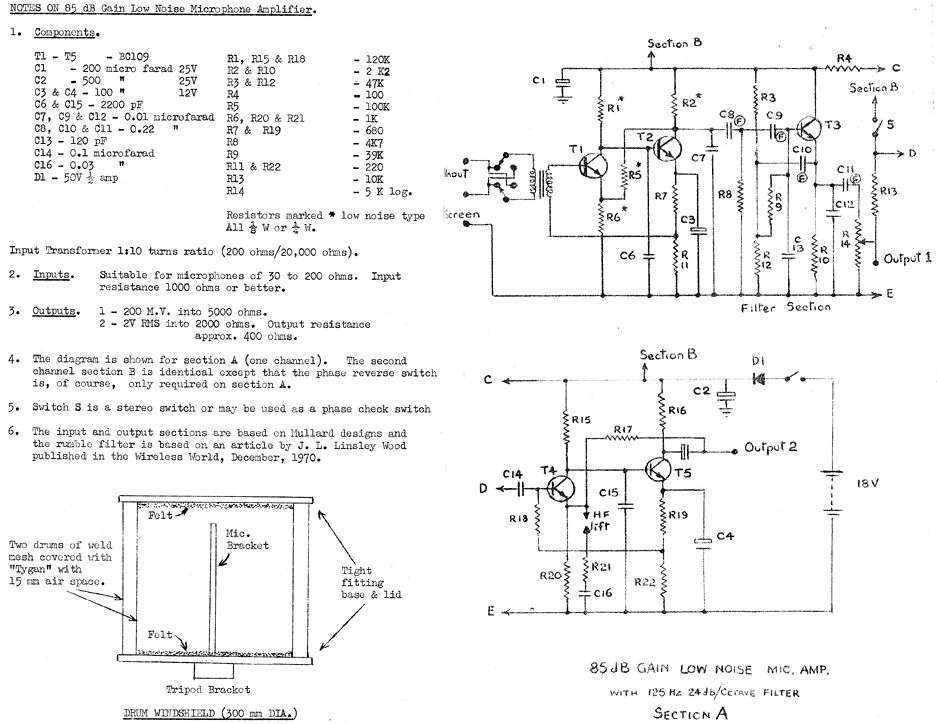
pure class a headphone amplifier schematic

The shunt-feedback configuration facilitates the straightforward integration of frequency-dependent networks, enabling a functional and discreet switchable tilt control (optional). When SW1 is in the first position, a gentle shelving bass boost and treble attenuation occur. The central position of SW1 provides a flat frequency response, while the third position of this switch activates a shelving treble boost and bass attenuation.
The described shunt-feedback configuration is an essential component in audio processing circuits, particularly in equalization applications where frequency response manipulation is necessary. This configuration allows for the incorporation of passive or active filters that can tailor the audio output according to user preferences or specific acoustic environments.
In this setup, the switch SW1 serves as a user interface to select between different frequency response characteristics. The first position of SW1 introduces a shelving filter that boosts low-frequency signals, enhancing bass response while simultaneously attenuating high frequencies. This is particularly useful in scenarios where low-end reinforcement is needed, such as in live sound reinforcement or in enhancing music playback in bass-heavy genres.
The central position of SW1 is critical for applications requiring a neutral sound profile, providing a flat frequency response that ensures the audio signal remains unaltered. This position is ideal for critical listening environments where fidelity to the original sound is paramount.
In the third position, SW1 implements a shelving treble boost while reducing bass frequencies. This configuration is advantageous in contexts where clarity and brightness of the audio signal are desired, such as in vocal performances or acoustic instruments, where excessive low frequencies might muddy the sound.
The integration of frequency-dependent networks in this shunt-feedback design not only enhances versatility but also maintains signal integrity, ensuring that the audio output remains unobtrusive and tailored to the listener's requirements. The optional tilt control feature adds an extra layer of customization, allowing users to fine-tune their audio experience in various settings. Overall, this configuration exemplifies a sophisticated approach to audio signal processing, merging functionality with user-friendly operation.The mentioned shunt-feedback configuration also allows the easy addition of frequency dependent networks in order to obtain an useful, unobtrusive, switchable Tilt control (optional). When SW1 is set in the first position a gentle, shelving bass lift and treble cut is obtained. The central position of SW1 allows a flat frequency response, whereas the third position of this switch enables a shelving treble lift and bass cut..
🔗 External reference
The described shunt-feedback configuration is an essential component in audio processing circuits, particularly in equalization applications where frequency response manipulation is necessary. This configuration allows for the incorporation of passive or active filters that can tailor the audio output according to user preferences or specific acoustic environments.
In this setup, the switch SW1 serves as a user interface to select between different frequency response characteristics. The first position of SW1 introduces a shelving filter that boosts low-frequency signals, enhancing bass response while simultaneously attenuating high frequencies. This is particularly useful in scenarios where low-end reinforcement is needed, such as in live sound reinforcement or in enhancing music playback in bass-heavy genres.
The central position of SW1 is critical for applications requiring a neutral sound profile, providing a flat frequency response that ensures the audio signal remains unaltered. This position is ideal for critical listening environments where fidelity to the original sound is paramount.
In the third position, SW1 implements a shelving treble boost while reducing bass frequencies. This configuration is advantageous in contexts where clarity and brightness of the audio signal are desired, such as in vocal performances or acoustic instruments, where excessive low frequencies might muddy the sound.
The integration of frequency-dependent networks in this shunt-feedback design not only enhances versatility but also maintains signal integrity, ensuring that the audio output remains unobtrusive and tailored to the listener's requirements. The optional tilt control feature adds an extra layer of customization, allowing users to fine-tune their audio experience in various settings. Overall, this configuration exemplifies a sophisticated approach to audio signal processing, merging functionality with user-friendly operation.The mentioned shunt-feedback configuration also allows the easy addition of frequency dependent networks in order to obtain an useful, unobtrusive, switchable Tilt control (optional). When SW1 is set in the first position a gentle, shelving bass lift and treble cut is obtained. The central position of SW1 allows a flat frequency response, whereas the third position of this switch enables a shelving treble lift and bass cut..
🔗 External reference





